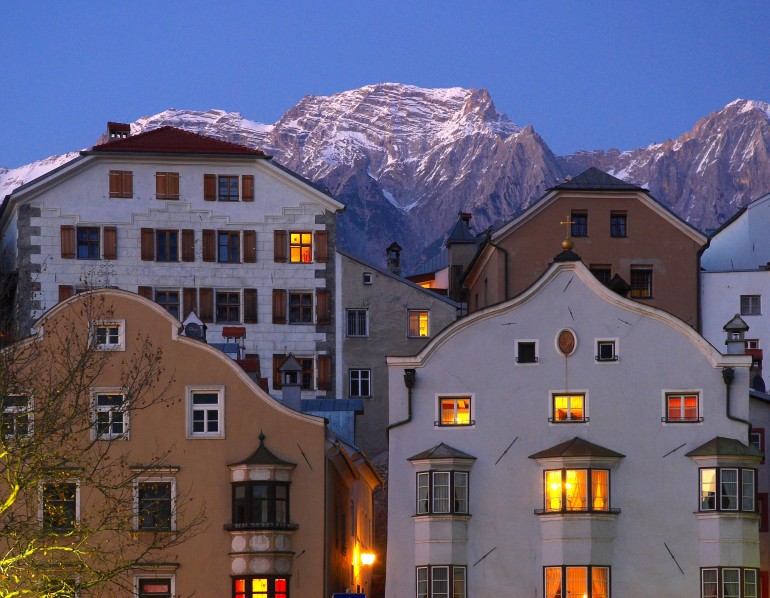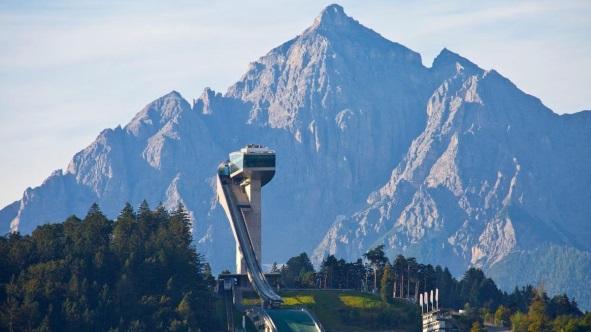Hall in Tirol is a town in the Innsbruck-Land district of Tyrol, Austria. Located at an altitude of 574 m, about 5 km (3 mi) east of the state's capital Innsbruck in the Inn valley, it has a population of about 13,000 (Jan 2013).
Hall in the County of Tyrol was first mentioned as a salina (saltern) near Thaur castle in a 1232 deed. The current name dates back to 1256, and similarly to Halle, Hallein, Schwäbisch Hall or Hallstatt is derived from the Celtic word for salt.
Since the 13th century the salt mine at Absam in the Hall Valley north of the town formed the main industry of the town and its surroundings. The first adit was laid out in 1272 at the behest of Count Meinhard II of Tyrol, with the brine channeled by a 10 km (6 mi) long pipeline to the evaporation pond at Hall. The importance of the salt industry, which exported goods as far as Switzerland, the Black Forest, and the Rhine valley, is reflected in Hall's coat of arms, which shows two lions holding a cask of salt. In 1303 Hall became a town. The rights that came with this, as well as the business associated with trading from Hall downriver on Inn and Danube, turned it into the leading market and trading place in the northern parts of Tyrol. Its development suffered a serious setback in 1447, when large parts of the upper town area were razed by a fire. In 1477 it got the right of coinage, when the Tyrolian mint was moved from Meran to Hall. It was here, in 1486, that the first high-grade silver Taler, the precursor of the dollar, was coined. In the 16th century the mint in Hall also introduced the world's first automated coining machine. Today a reconstruction of this revolutionary machine can be seen in the Hall Mint Museum in the Burg Hasegg.
In the 15th and 16th century, Hall was one of the most important towns in the Habsburg Empire. This period saw the construction of many of the churches, monasteries and convents that still shape the appearance of the town. Today Hall has the biggest intact old town in the western part of Austria.
During the Habsburg Monarchy a military garrison was established in Hall. This, along with the large freight train station, became a target of heavy bombardment during World War II, which destroyed the train station but left the old town almost unscathed.
From 1938 to 1974 the town was called Solbad Hall - Solbad was dropped from the town name a few years after the salt mining was closed in 1967.
(Source: https://en.wikipedia.org/wiki/Hall_in_Tirol)
Tourist and cultural interests:
 Hall is a vibrant small town full of vitality where you can experience varied shopping facilities and classy hospitality amidst buildings rich in history. You will get to see one of Tirol's most scenic towns if you take a discovery tour through the medieval town of Hall. The lovingly restored old town, which ranks among Austria's best preserved old towns and which is even larger than the one of the provincial capital of Innsbruck, represents a perfect blend of medieval elements and modern architectural concepts.
Hall is a vibrant small town full of vitality where you can experience varied shopping facilities and classy hospitality amidst buildings rich in history. You will get to see one of Tirol's most scenic towns if you take a discovery tour through the medieval town of Hall. The lovingly restored old town, which ranks among Austria's best preserved old towns and which is even larger than the one of the provincial capital of Innsbruck, represents a perfect blend of medieval elements and modern architectural concepts.
 The attractive buildings of the old town of Hall are evidence of the past of the wealthy town: In the Middle Ages, Hall turned into one of the most significant business locations of North Tirol thanks to the salt production. The town already used to be an important place for trading at the river Inn in the Middle Ages. The sovereign mint, which was located in Hall from the middle of the 15th century, considerably contributed to the ongoing economic prosperity. The old town of Hall and the area around the Burg Hasegg castle with its mint tower and the adjacent mint museum captivate visitors from all over the world throughout the year.
The attractive buildings of the old town of Hall are evidence of the past of the wealthy town: In the Middle Ages, Hall turned into one of the most significant business locations of North Tirol thanks to the salt production. The town already used to be an important place for trading at the river Inn in the Middle Ages. The sovereign mint, which was located in Hall from the middle of the 15th century, considerably contributed to the ongoing economic prosperity. The old town of Hall and the area around the Burg Hasegg castle with its mint tower and the adjacent mint museum captivate visitors from all over the world throughout the year.
 Innsbruck, the “capital of the alps” delights with its unique wealth of wonderful attractions between 574 and 2,350 meters above sea level. Alpine-urban, sporty, dynamic and cosmopolitan yet charming, strong and traditional – Innsbruck is a city with exceptional appeal. Innsbruck offers diverse cultural events, world-famous attractions, exciting city tours, great highlights in the center and surrounding mountains, genuine hospitality, modern lifestyle and sporting flair. Nowhere else are alpine experiences and urban joie de vivre so closely connected.
Innsbruck, the “capital of the alps” delights with its unique wealth of wonderful attractions between 574 and 2,350 meters above sea level. Alpine-urban, sporty, dynamic and cosmopolitan yet charming, strong and traditional – Innsbruck is a city with exceptional appeal. Innsbruck offers diverse cultural events, world-famous attractions, exciting city tours, great highlights in the center and surrounding mountains, genuine hospitality, modern lifestyle and sporting flair. Nowhere else are alpine experiences and urban joie de vivre so closely connected.